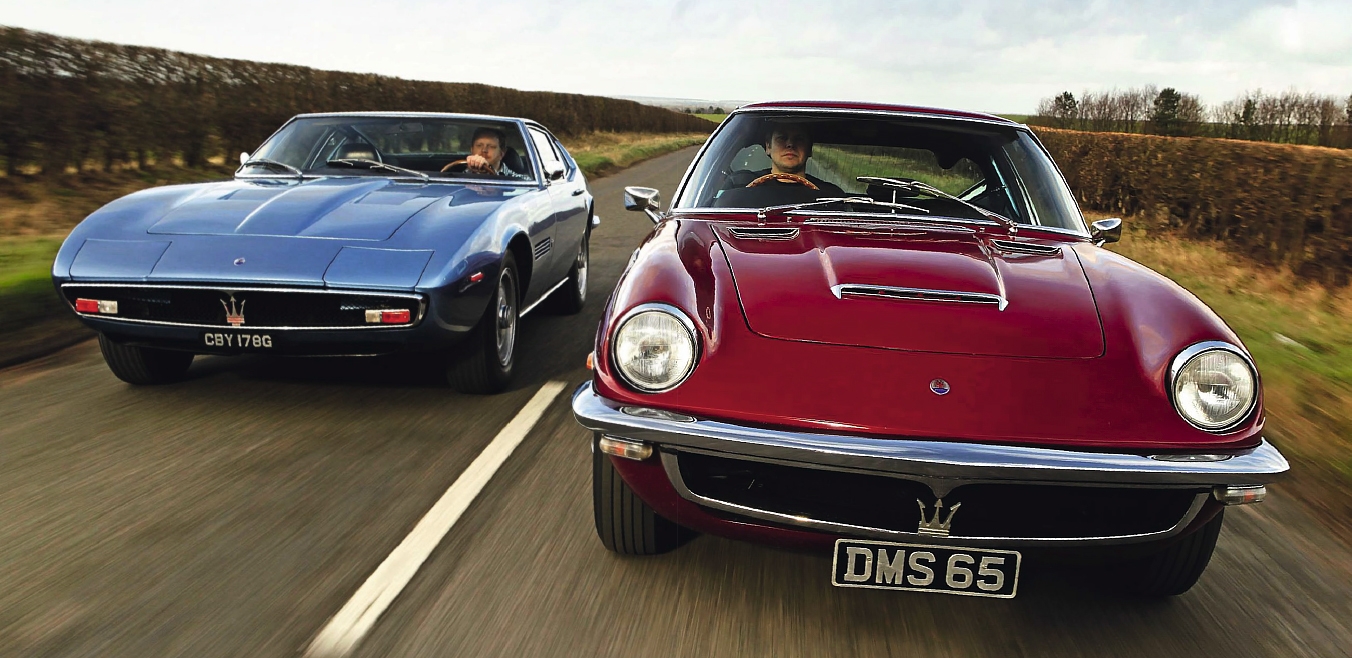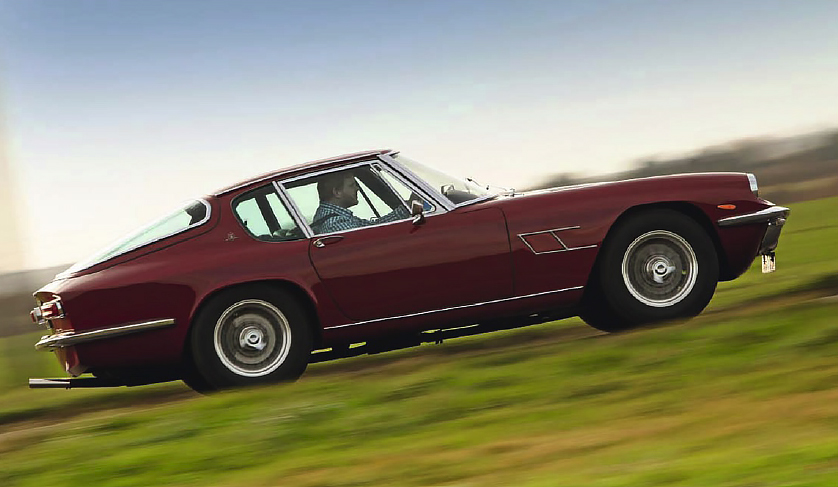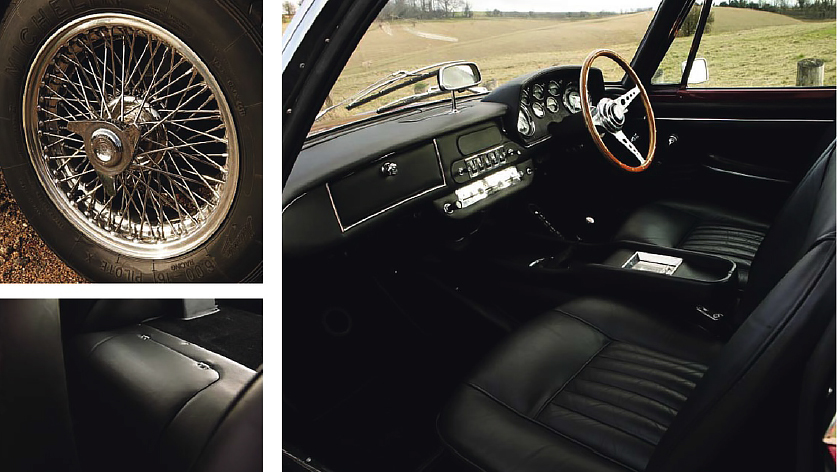
Bridging the gap. The Ghibli and Mistral marked a generation change for Maserati. Alastair Clements tries to choose between them. Photography Tony Baker. Maserati in 2014, like most successful luxury marques, is all about brand extensions and exploiting high-net- worth niches. The market place of the late 1960s was a very different landscape, in which having a large range of costly-to-make, tricky-to-sell top-end cars wasn’t great for the immediate bottom line or your long-term health prospects. So it comes as something of a surprise to peer at a 1969 price list and find, alongside the Quattroporte, not one but seven different flavours of Maserati two-door coupe, with prices ranging from £6871 to £10,180.

Frua’s Mistral detailing is awkward in places, yet the whole design works beautifully. Top, l-r: alloy twin-cam ‘six’ looks and sounds every inch the thoroughbred, delicate chromed wing vents.
Look closer, and you realise that the cars that top and tail the list marked a changing of the guard at the Viale Ciro Menotti factory in the latter days of the Orsi era. Ever since the 6CM and its A6 sports-racing and road going developments, the firm’s flagships both on and off the track had been powered by a gradually growing family of straight-six engines. By the early ’60s, however, it was becoming obvious that some-thing new was needed, a powerplant exotic enough to be worthy of the name and powerful enough for Maserati’s most exclusive models to stand comparison with the likes of Ferrari, Aston Martin and upstart Lamborghini. Enter a quad-cam V8 that, like the ‘six’ before it, would go on to power a whole dynasty, from mid-engined supercars to saloons and super coupes.
Hold on, you may be thinking, you can’t call the Ghibli the first of a new generation can you? After all, the V8 had been around since the turn of the decade in the 5000GT and Quattroporte. Perhaps not the first, then, but the aggressive wedge-shaped GT was very much the poster- boy for the engine that would be a mainstay for the firm through to the ’80s and survive until the demise of the Quattroporte III in 1990.

Clockwise, from main: non standard Moto-Lita wheel adds to traditional feel; useful bins behind seats; Borrani wires – later cars could have Ghibli-style alloys. Top: handling is from an earlier time.
Yet from 1967 to 1970 these two cars were sold from the same showrooms, offering well- heeled playboys and magnates an intriguing choice. They were even targeting the same buyer: one seeking an exclusive, high-performance, hand-built luxury two-seater. The kind of GT car that would keep a Lamborghini Miura in sight on a cross-continental blast, yet do so with space for a set of Louis Vuitton luggage and arrive without roasting its occupants or leaving them needing expensive osteopathy.
The Tipo AM109 fits these criteria admirably. So understated is this GT, introduced at the 1963 Turin Show, that it is hard to conceive that its engine is based – albeit fairly loosely – on that of the legendary 250F and 300S racers. For the road car the focus was tractability and reliability, with chain rather than gear drive for the double overhead cams and Lucas indirect mechanical injection replacing Webers, but the family line-age was clear. The unit was directly developed from the 3500GT, but only a few Spyders would be 3 ½ litres with most – such as this 1965 car – using a 245bhp, 3694cc version or, from 1966, the 4-litre introduced at the Geneva Salon, the final evolution of the straight-six engine.

Sleek, wedge-shaped lines are the work of Giorgetto Giugiaro at the peak of his abilities. Top, l-r: cultured quad-cam V8 is powerful and sonorous, yet also refined; lovely shape was metal by Ghia.
It is appropriate that thus far we haven’t given it a name, because for a year the new Maserati was known simply as the Berlina Due Posti (two-seater saloon) before French importer Colonel John Simone set a Trident trend by suggesting it be called Mistral after a coastal Mediterranean wind. There isn’t even a badge on this car, the burgundy coachwork of which perfectly accentuates the subtle Pietro Frua-styled lines. Frua had been a popular choice for the fickle Maserati during the A6G era, and for the short-wheelbase Mistral – the 3500 had an additional 100mm between the axles – he created a pretty hatchback coupe that was formed in aluminium by fellow Torinese carrozzeria Maggiora.

Clockwise, from main: Ghibli cabin is as modern and stylish as the exterior; sparing use of chrome lifts the black leather; Campagnolo alloys with fake centre-lock caps. Top: wide track gives fine grip.
It’s no fire-breather, but you can hear that grand prix heritage in its raucous bark.
The first Maserati road car to do without a traditional grille, the Mistral’s air intake was beneath the bumper and there were delicate chrome accents for the wing vents and fuel-filler. The detailing is fussy, almost awkward in places, but the whole is a visual treat, with a continuous line running under the headlights, over the arches and beneath the fabulous glass tailgate.
But style was only a part of the Maserati package during the golden era under chief engineer Giulio Alfieri, who joined in 1953. Comfort and performance were equally important, and the former certainly hasn’t been forgotten. The driving position is upright, the pedals offset slightly to the right, but the seats are deeply padded and there’s a charming traditional feel. The leather-clad dash is fronted by a large, clear instrument binnacle and there are delightful hand-crafted details such as little lever-operated vents in the foot wells. Behind, there’s a vast boot – into which, as in the Ghibli, you could specify a couple of jump-seats in later cars – and that focus on comfort is further reinforced by an options list that included air-conditioning and even a three-speed automatic transmission.
MARKETWATCH
Andy Heywood, McGrath Maserati
Prices have been climbing for several years, but they have really accelerated recently. We first noticed a hardening of values of really good cars, but now that has filtered down. The Ghibli is more commercially desirable because it’s such an iconic shape, whereas Mistrals are not so accessible – people only tend to get into them after learning about Maserati in depth.
Ghiblis have gone from around £40k for a really good one seven years ago to £120k today. A nice 4.7 is a £100k car, a pukka restored SS is £150k and a Spyder £1/2m. The Mistral market has changed relatively quickly and dealers are preying on them, but some haven’t caught up so you do still see them in the £30,000s. Five years ago that would have got you a nice car; now it’ll be a non-runner. In the ’80s the Mistral Spyder was the car, but now the Ghibli has overtaken it and the 3500GT Spyder is the most coveted of all. A good Mistral coupe today is £100k- and you can add £30k for one of the last of the 4-litres – while a Spyder is £250-300,000.
For me, it has to be a Ghibli: I just love the shape, and some of my best journeys have been in Ghiblis. A 4.9 SS with power steering is a car you can go anywhere in!
Tick that last box, however, and you would be missing the point. It is a comfortable GT, but it’s also a car with true thoroughbred breeding. T) bring it to life, leave the throttle alone and use the cold-start to avoid flooding the injection; after a churn, that glorious straight-six bursts into life, rumbling unevenly until it warms, then ticking over with the dieselly grumble of the gear drive from the crank to the cam chains.
The Lucas injection doesn’t have a great reputation for reliability, but when it’s right you can’t imagine ever swapping it for Webers. There are no histrionics, and the fantastic torque means that the twin-cam, twin-plug motor pulls from walking pace without a cough, delivering a sustained surge that has pretty much given its best by 4500rpm – still 10000rpm short of the redline. The ZF gearchange isn’t particularly fast, and ideally you want to leave second alone until it’s warm, but the tiny lever snicks across the gate with a deliciously mechanical precision. Yet the real treat is the soundtrack: it’s no fire- breather, but you can feel – and hear – that GP heritage in its raucous bark. Close your eyes and you could be in the Goodwood paddock.
Barrelling along twisty rural Cambridgeshire roads, there’s a touch of wander from the low- geared steering – the box may need adjusting – but it’s beautifully weighted, smooth and accurate, quickly shedding its low-speed heft. The payoff for a supple ride is some roll, but it remains composed under most conditions, only upset by mid-corner ruts that show up the live rear axle with a hop and a skip. Like a ’50s GT, the Mistral likes to move around on its relatively skinny 6.00xl6in rear tyres, but it always encourages enthusiasm with its agile, eager responses.
Stepping from the upright Mistral and drop-ping into the low-set, reclined seat of the Ghibli, it’s hard to believe that both came from the same maker at the same time – although the name is a good clue, taken this time from a hot, dry North African wind. It’s as if the world around you is in fast-forward, moving from a machine that feels rooted in the ’50s to one whose focus is clearly the approaching ’70s. The later car feels more of-a-piece than the Mistral, albeit at the cost of seeming a touch less bespoke. Inside, just as without, it feels more rational, less random, with consistent detailing that is beautifully executed to hide any parts-bin raiding. And there was plenty of that to ensure that there was every luxury, from air-con to electric windows.
The Tipo AM115 was launched at Turin in 1966- but with few customers getting their cars until late ’67 – and was arguably the first overtly showy Maserati. Earlier cars had plenty of chrome, yes, but seemed almost apologetic about their ostentation, while the gorgeous Ghibli shouted its potency and luxury from the rooftops thanks to the precocious talents of a youthful Giorgetto Giugiaro at Ghia.
The futuristic wedge with pop-up lamps appears unfeasibly low: muscular without being brash, it has minimal chrome yet the overall effect is far more extravagant. That Giugiaro was able to get it so ground-hugging is testament to the work of the engineers: the four-cam V8 was loosely based on that of the exotic 5000GT, itself a development of the hairy 450S sports-racer’s V8, but for the Ghibli it was further civilised with single plugs, a quartet of twin-choke Webers – 42DCNF on this ’69 example – and, crucially, dry-sump lubrication to allow that super-low bonnet line.
The V8 is a complex symphony of moving parts meshing in perfect harmony.
Unlike the Miura and Daytona against which it was inevitably compared, the Ghibli’s spec was otherwise largely unexciting: it persevered with a cart-sprung live rear end, with only an antitramp bar to help keep it in check. Yet it was both potent and forgiving – and fast. Even in 4.7-litre form it mustered 310bhp, and the mighty 4.9-litre SS – up-engined to mask the effect of Federal emissions regs – had 335bhp, making it at the time Maserati’s fastest road car to date. In spite of its racer origins, the V8 produces a more refined, more cultured sound than the Mistral – and a far more exotic timbre than a pushrod V8 as it spins freely with a complex symphony of moving parts meshing in perfect harmony.
Some of that power is masked by the additional 220kg of the all-steel Vignale-built body, which reduces the gap between the two cars to just 10bhp/tonne, but the Ghibli still feels the faster. In fact, it feels more capable all round: the vented discs inspire confidence; the fatter tyres and 2in wider track give a huge boost in grip and balance; and that additional weight helps it seem more stable, quashing with authority bumps that might upset the lighter, nimbler Mistral.
Hustling this Ghibli is a physical experience, without the power-assisted steering more commonly specified on later cars, but despite the weight of the helm and the hefty, long-throw ZF gearchange, the Ghibli feels instantly familiar. You sit so low beneath that shallow glasshouse that it’s tricky to judge the corners – even for a six-footer – but perhaps the biggest drawback on these narrow lanes is the car’s sheer width, its additional 5in over the Mistral making passing local buses a nerve-racking experience.
Wind back to 1969, then, and which car does our wealthy buyer pick? The cost differential means nothing to him – other than adding to the sense of the Ghibli being a bit more flash than the almost self-consciously discreet Mistral. On a purely objective basis, the Ghibli wins hands down. It’s the prettier shape, the more complete and capable GT – and for most that is more than enough. For all of its obvious sexiness, however, it somehow lacks some of the romance of the earlier car, and it’s the Mistral that lingers longer in the heart. It may not be the better car, but for a true romantic it’s the better Maserati.
| Car | Maserati Ghibli | Maserati Mistral |
| Made as | Italy | |
|
Sold |
1967- 1973 |
1963-1970 |
| Number built |
1170 (all, plus 125 Spyders)
|
828 (all, plus 125 Spyders) |
| Construction |
steel monocoque, steel body, steel ladder chassis |
aluminium body, steel platform chassis |
| Engine |
all-alloy, dohc-per-bank 4709cc (SS 4930cc) dry-sump 90° V8, with four Weber carburettors |
all-alloy, dohc, twin-plug 3694cc (or 3485/4014cc) straight-six, with Lucas mechanical fuel injection
|
| Max power | 310bhp @ 6000rpm |
245bhp @ 5500rpm |
| Max torque |
341lb ft @ 4000rpm | 275lb ft @ 3600rpm |
| Transmission |
ZF five-speed manual, RWD | ZF five-speed manual, RWD |
| Suspension |
front independent, by wishbones, coil springs rear live axle, semi-elliptic springs; telescopic dampers, anti-roll bar f/r
|
front independent, by wishbones, coil springs rear live axle, semi-elliptic springs; telescopic dampers, anti-roll bar f/r
|
| Steering |
worm and sector |
worm and sector |
| Brakes |
dual-circuit ventilated discs, with servo
|
dual-circuit discs, with servo
|
| Measurements |
Length 15ft 5in (4700mm) Width 5ft 10in (1790mm) Height 3ft 9 1/2in (1160mm) Wheelbase 8ft 4 1/2in (2550mm)
|
Length 14ft 9 1/4in (4500mm) Width 5ft 5 3/4in (1675mm) Height 4ft (1300mm) Wheelbase 7ft (2400mm)
|
| Weight | 3637lb (1650kg) |
Weight 3152lb (1430kg)
|
| 0-60mph |
6.4 secs |
6.2 secs |
| Top speed |
174mph |
155mph |
| Mpg |
18 |
14 |
| Price new |
new £10,180 (1969) |
£6871 (1969) |
| Price now |
£100,000 |
£100,000
|
Thanks to owners Mark Guterres and Brian Harris; McGrath Maserati (01438 832161; mcgrathmaserati.co.uk); Longstone Classic Tyres (01302 714072; longstonetyres.co.uk)





